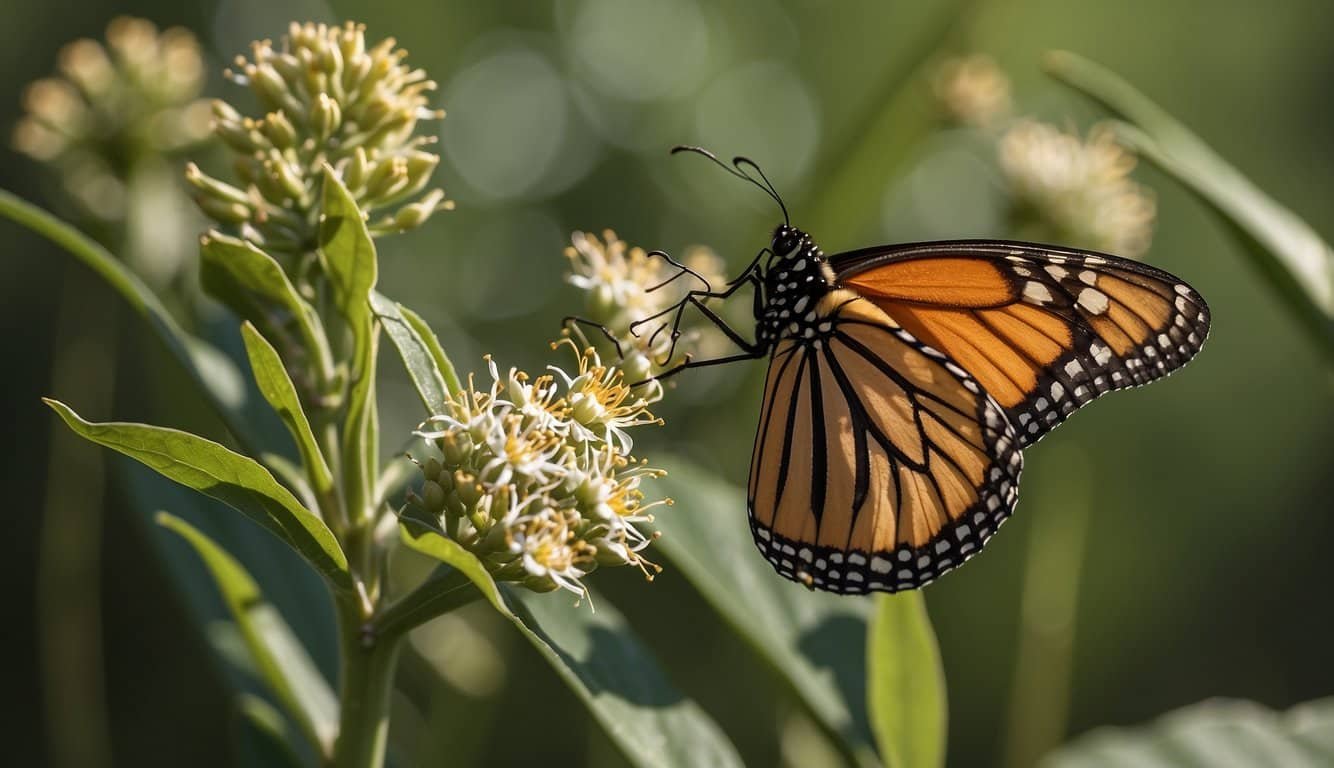Monarch Butterfly Overview
The monarch butterfly, Danaus plexippus, is a well-known species that graces many gardens with its striking orange and black patterned wings. With a unique life cycle that includes a mass migration, these insects captivate both scientists and enthusiasts alike.
Species and Taxonomy
The monarch butterfly, or Danaus plexippus, belongs to the order Lepidoptera, the group that encompasses all butterflies and moths. This species is part of the Nymphalidae family, which is known for the distinctive brush-footed butterflies. Monarchs are not only celebrated for their beauty but also for their impressive migratory patterns.
Physical Characteristics
The most recognizable features of a monarch butterfly are its vibrant orange wings edged with black lines and bordered with small white spots. The wings of the monarch are a marvel of nature, not only for their striking coloration but also for their functionality. With a wingspan ranging from 3.5 to 4 inches (89 to 102 millimeters), monarchs are built for long-distance travel. These winged adventurers rely on their colored patterns for camouflage and to ward off predators during their lengthy flights.
Life Cycle and Reproduction

The life cycle of the monarch butterfly is a fascinating journey from egg to adult, incorporating dramatic transformations at each stage. Their reproductive process is closely tied to their lifecycle, ensuring the continuation of the species.
Developmental Stages
Monarch butterflies undergo a process known as complete metamorphosis which includes four distinct stages: egg, larva (caterpillar), pupa (chrysalis), and adult butterfly. Females lay their eggs on the underside of milkweed leaves. After about four days, the eggs hatch into caterpillars that feed voraciously on milkweed, which is toxic to most predators but harmless to them. This stage lasts for about two weeks.
The caterpillar then weaves a protective casing around itself, forming the chrysalis. Inside, the caterpillar’s body undergoes a remarkable transformation, emerging after about ten days as an adult butterfly. This metamorphosis from a caterpillar into an adult butterfly is one of nature’s most extraordinary processes, showcasing the resilience and complexity of life cycles in insects.
Breeding and Lifespan
Monarch butterflies have a unique yearly breeding cycle that includes migration. In North America, monarchs will breed throughout the warmer months, laying eggs that will become the new generation that migrates to Mexico for overwintering. It is during the breeding season that the population of monarch butterflies can be impacted by habitat loss, as described in research regarding population declines of monarch butterflies.
Their lifespan varies depending on the time of year they mature. Monarchs that emerge in early summer have the shortest lifespan of 2 to 6 weeks, as they must focus on breeding. Those that emerge later in the year and become part of the migrating generation can live up to 8 months. They delay their reproduction until after the winter, entering a phase known as reproductive diapause which allows them to survive longer, contributing to the next generation following their return from migration. Studies on this diapause can further elucidate the reproductive pause in monarch butterflies. Females typically lay hundreds of eggs over their lifetimes to ensure some offspring survive to adulthood, though only a small percentage of these eggs reach maturity.
Migration and Conservation

The monarch butterfly, an icon of North American wildlife, embarks on an incredible journey each year, facing multiple conservation challenges along the way. This section delves into their awe-inspiring migration patterns, the environmental hurdles they encounter, and how human interaction plays a pivotal role in their future.
Migration Patterns
Monarch butterflies are known for their impressive migratory journey that can cover thousands of miles, with masses traveling from Canada and the United States to overwintering sites in Central Mexico and Southern California. As temperatures drop in the fall, monarchs use a combination of air currents and thermals to travel to their winter habitats, a phenomenon that continues to fascinate scientists and nature enthusiasts alike.
Habitat and Environmental Concerns
Monarch butterflies depend on a range of habitats across North America, but changes in climate and land use have impacted their food source, the milkweed plant, and their overwintering habitat. Deforestation in Mexico and losses of natural habitat due to urban development are among the critical threats. Additionally, climate change intensifies the severity and frequency of storms and temperature fluctuations, further stressing monarch populations.
Human Interaction
The fate of the monarch butterfly is tightly intertwined with human activity. From pesticide use that diminishes milkweed availability to conservation projects aimed at protecting critical habitats, human influence is undeniable. The rise in awareness and involvement in protection efforts, such as planting nectar-rich flowers and reducing pesticide use, is essential for the survival of this endangered wonder. Moreover, engaging in citizen science projects helps track the health and size of monarch populations.

